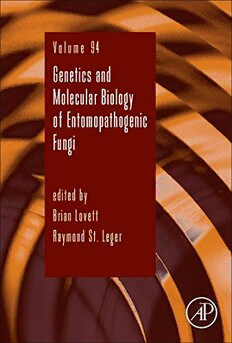
Genetics and Molecular Biology of Entomopathogenic Fungi PDF
Preview Genetics and Molecular Biology of Entomopathogenic Fungi
VOLUMENINETYFOUR A DVANCES IN GENETICS Genetics and Molecular Biology of Entomopathogenic Fungi ADVANCES IN GENETICS, VOLUME 94 Serial Editors Theodore Friedmann Department of Pediatrics, University of California at San Diego, School of Medicine, CA, USA Jay C. Dunlap DepartmentofGenetics,TheGeiselSchoolofMedicineatDartmouth, Hanover, NH, USA Stephen F. Goodwin Department of Physiology, Anatomy and Genetics, University of Oxford, Oxford, UK VOLUME NINETY FOUR A DVANCES IN GENETICS Genetics and Molecular Biology of Entomopathogenic Fungi Edited by BRIAN LOVETT University of Maryland, College Park, MD, United States RAYMOND J. St. LEGER University of Maryland, College Park, MD, United States AMSTERDAM(cid:129)BOSTON(cid:129)HEIDELBERG(cid:129)LONDON NEWYORK(cid:129)OXFORD(cid:129)PARIS(cid:129)SANDIEGO SANFRANCISCO(cid:129)SINGAPORE(cid:129)SYDNEY(cid:129)TOKYO AcademicPressisanimprintofElsevier AcademicPressisanimprintofElsevier 50HampshireStreet,5thFloor,Cambridge,MA02139,USA 525BStreet,Suite1800,SanDiego,CA92101-4495,USA 125LondonWall,LondonEC2Y5AS,UK TheBoulevard,LangfordLane,Kidlington,OxfordOX51GB,UK Firstedition2016 Copyright©2016ElsevierInc.Allrightsreserved. Nopartofthispublicationmaybereproducedortransmittedinanyformorbyanymeans,electronicor mechanical,includingphotocopying,recording,oranyinformationstorageandretrievalsystem,without permissioninwritingfromthepublisher.Detailsonhowtoseekpermission,furtherinformationabout thePublisher’spermissionspoliciesandourarrangementswithorganizationssuchastheCopyright ClearanceCenterandtheCopyrightLicensingAgency,canbefoundatourwebsite:www.elsevier.com/ permissions. ThisbookandtheindividualcontributionscontainedinitareprotectedundercopyrightbythePublisher (otherthanasmaybenotedherein). Notices Knowledgeandbestpracticeinthisfieldareconstantlychanging.Asnewresearchandexperience broadenourunderstanding,changesinresearchmethods,professionalpractices,ormedicaltreatment maybecomenecessary. Practitionersandresearchersmustalwaysrelyontheirownexperienceandknowledgeinevaluatingand usinganyinformation,methods,compounds,orexperimentsdescribedherein.Inusingsuchinformation ormethodstheyshouldbemindfuloftheirownsafetyandthesafetyofothers,includingpartiesfor whomtheyhaveaprofessionalresponsibility. Tothefullestextentofthelaw,neitherthePublishernortheauthors,contributors,oreditors,assumeany liabilityforanyinjuryand/ordamagetopersonsorpropertyasamatterofproductsliability,negligence orotherwise,orfromanyuseoroperationofanymethods,products,instructions,orideascontainedin thematerialherein. ISBN:978-0-12-804694-4 ISSN:0065-2660 ForinformationonallAcademicPresspublicationsvisitour websiteathttps://www.elsevier.com Publisher:ZoeKruze AcquisitionEditor:ZoeKruze EditorialProjectManager:HeleneKabes ProductionProjectManager:VigneshTamil Designer:GregHarris TypesetbyTNQBooksandJournals DEDICATION The editors dedicate this book to the doyen of insect pathology, Donald Roberts, and to his versatile little friend Metarhizium robertsii. j v CONTRIBUTORS J.P.M.Araújo Pennsylvania State University, University Park, PA,UnitedStates L.Barelli Brock University, St.Catharines, ON, Canada M.J. Bidochka Brock University, St.Catharines, ON, Canada T.M.Butt Swansea University, Swansea,Wales,UnitedKingdom C.J. Coates Swansea University, Swansea,Wales,UnitedKingdom C.de Bekker Ludwig-Maximilians-University Munich,Munich, Germany H.H. De FineLicht University of Copenhagen, Frederiksberg, Denmark B.G.G. Donzelli Cornell University, Ithaca, NY,UnitedStates I.M.Dubovskiy SBRussian Academy of Sciences, Novosibirsk, Russia J. Eilenberg University of Copenhagen, Frederiksberg, Denmark H.C. Evans CAB International, Surrey,UnitedKingdom W.Fang Zhejiang University,Hangzhou, Zhejiang, China A.E. Hajek Cornell University, Ithaca, NY,UnitedStates D.P. Hughes Pennsylvania State University, University Park, PA,UnitedStates A.B. Jensen University of Copenhagen, Frederiksberg, Denmark N.O. Keyhani University of Florida, Gainesville, FL,UnitedStates S.B. Krasnoff USDA-ARS, Ithaca,NY,United States j xi xii Contributors R.G.Loreto Pennsylvania State University,University Park, PA, UnitedStates; CAPES Foundation, Ministryof Education of Brazil, Brasília,DF,Brazil B.Lovett University of Maryland, College Park, MD,UnitedStates H.-L.Lu University of Maryland, College Park, MD,UnitedStates S.Moonjely Brock University,St. Catharines, ON, Canada A.Ortiz-Urquiza University of Florida, Gainesville,FL, UnitedStates L.Quevillon Pennsylvania State University,University Park, PA, UnitedStates N.A. Ratcliffe SwanseaUniversity,Swansea,Wales,UnitedKingdom;UniversidadeFederalFluminense, Niteroi,Rio deJaneiro, Brazil R.J. St.Leger University of Maryland, College Park, MD,UnitedStates C.Wang Chinese Academy of Sciences, Shanghai,China J.B.Wang University of Maryland, College Park, MD,UnitedStates H.Zhao Zhejiang University,Hangzhou, Zhejiang, China PREFACE Insects are the most species-rich group of eukaryotes, and this diversity grants these animals profound power to influence ecosystems. The great research interest in insects arises from their ability to negatively impact human society: as vectors for disease in humans and our livestock and as destroyers of crops and stored products. It is estimated that insects destroy approximately18%oftheworldannualcropproduction,andvectorborne diseaseskillmillionseveryyear.Thus,thediseases,pathogens,andimmune responses of insects have been a long-standing research interest. Early interest grew mostly from economic concerns. For example, Beauveria bassiana was described by Agostino Bassi in 1835 as the cause of the devas- tating muscardine disease of silkworm, and it was instrumental in his development of the germ theory of disease (Steinhaus, 1956). In 1880, the pioneer immunologist Elie Metchnikoff was among the first to propose practical methods of microbial biological control of an insect crop pest, initiating trials of the fungus Metarhizium anisopliae against grain beetles (Lord, 2005; Mechnikoff, 1879, Fig. 1). Suchappliedinterestcontinuestoday,asweallstillhaveastakeineither lengthening the life expectancy of useful insects or shortening the life expectancy of pestiferous ones. Since fungi are the commonest disease- causing agents in insects and populations of most insects are regulated by density-dependent factors involving pathogens and predators, we need to understand and be able to manipulate the interactions of pest insects with fungiandtheirothernaturalenemiesinordertofeedtheworldandprevent disease.Mostresearchonfungal-insectpathogenshascontinuedtofocuson hypocrealean Ascomycetes from the genera Beauveria and Metarhizium (familyCordycipitaceaeandClavicipitaceae,respectively).Thesegeneraare tractablemodelspecies,arereadilycultivatable,andhaveaparticularlywide host range allowing them to be applied en masse against vectors of human disease and multifarious agricultural pests. Numerous registered mycoin- secticideformulationsarebasedonBeauveriaandMetarhiziumspp.Theyalso have a worldwide distribution with variants adapted from the arctic to the tropicsandcolonizinganimpressivearrayofenvironmentsincludingforests, savannahs, swamps, coastal zones, and deserts. The majority of chapters in this volume focus on Metarhizium and Beauveria, reflecting the preponderance of published data that has utilized j xiii xiv Preface Figure 1 (1) Blood cells and fungal conidia from the blood of dying wheat chafer larvae.Magnified550times(Eyepiece3+System9alonepicture).(2)Fungalconidia from the blood of living and apparently healthy larvae. Magnified 860 times (4+9). (3)Piecesofsubcutaneousmycelialconidiophoresformedonfreshcadavers.Magnified Preface xv thesegeneraasmodelsforentomopathogenicity.Yet,asclarifiedbyArau(cid:1)jo and Hughes in Chapter 1, most major fungal taxonomic groups have memberspathogenictoinsects,sofungal-insectpathogensrepresentlifestyle adaptations that have likely evolved numerous times. Arau(cid:1)jo and Hughes emphasize that, despite their ecological importance and potential applica- tions, the entomopathogenic fungi are woefully understudied, especially regardingtheirbiodiversity,whichlikelyharborsoneofthelargestreservoirs of undocumented fungal species. Their chapter provides a broad overview of host–pathogen relationships by focusing on the impressive diversity of morphologies,ecologies,andinteractionsbetweeninsectsandfungi.Ashost andpathogenaretiedtogetherinaveryintimaterelationship,thepresented work strongly argues for empirical studies investigating both sides of the relationship in a much broader range of fungal-insect interactions than has hitherto been conducted. The authors reveal significant differences in host range and pathogenic strategies between the major groups of fungal pathogens.Thebasalgroups,suchasaquaticchytrids,infectmostlyDiptera, while Microsporidia and Entomophthoromycota infect a wide range of hosts.BasidiomycotainfectsmostlyHemiptera,whileAscomycota,themost species-rich group, infects a vast number of insect groups. In terms of pathogenicstrategies,theascomycetes,forexample,areallhemibiotrophic, switching from a biotrophic phase (parasitism) to a necrotrophic phase, growing on the dead host. Incontrast,theEntomophthoromycotaarecharacteristicallybiotrophics with no somatic growth after death. =--------------------------------------------------------------------------------------------------------------------------------------------------------------------------------------------------------------------------------------------------------------------- 550times.(4)Conidiafromwithinthesamelarvaeonthedayafterdeath.Magnified 550times.(5)Overgrownconidiaonthethirddayemergingfromthelarvalcadaverina humidchamber.Magnified400times(3+8).(6)Conidiaandhyphaewithtwoforming conidia(a)inahumidifiedchamber.Magnified400times.(7)Candelabra-shapedstalks with sterigmata forming conidia cultured in a humid chamber. Magnified 400 times. (8) Mature Entomophthora anisopliae spores. Magnified 1340 times (Eyepiece 3+14 System picture). (9) Cross section of larva covered with fungus. a-conidial layer, b-straighthyphallayer,c-feltedlayer,d-candelabralayerwithsterigmataandconidia. Magnified 90 times (3+4). (10) Three conidia grown in sugar water. Magnified 550 times. (11) Germinating spores on larval cuticle. a, b- Spore germ tubes producing yellowspots.c-Bursiformgermliningsonthecuticle.d-Furtherstageofgermination. e- Spot on larval cuticle with ungerminated and germinating conidia. Magnified 550 times.(12)Spotsonthecuticlewithsproutslikeraysofradiatinghyphae;withnotable formation of conidia. Magnified 400 times. This figure is from Elie Metchnikoff’s pub- licationdiscoveringMetarhiziumanisopliaeinOdessain1879;thelegendisatranslation ofhisoriginalRussianlegendforthefigure.
